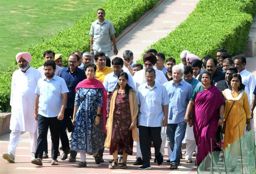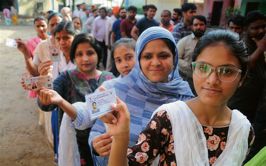
Commendable: The National Institute of Nutrition has flagged aggressive marketing of unhealthy ultra-processed food products and misleading food labels. istock
Science Commentator
THE Hyderabad-based National Institute of Nutrition (NIN), one of the oldest research laboratories under the Indian Council of Medical Research (ICMR), released the ‘Dietary Guidelines for Indians’ last week. The document comes as a breath of fresh air amidst the cacophony of advice on nutrition, food and diet from thousands of self-appointed experts and social media influencers. A bulk of the fake news and disinformation relates to food and nutrition. Food companies and food delivery apps make consumers believe that eating ‘ghar ka khaana’ is a sin, while food vloggers tout outlandish food products laden with sugar, salt and fats as authentic and exotic. Self-styled nutritionists and celebrities often lure gullible consumers with food fads (intermittent fasting, paleo diet, etc). ‘Healthy’ and ‘fresh’ are used as brand names for factory-made food products that have nothing to do even remotely with health or freshness.
The limited availability and high cost of pulses and meat are forcing people to rely more on cereals.
In such a discordant food environment, it is refreshing to see a public-funded research centre come up with evidence-based dietary guidelines for people across age groups and regions. For nearly a century, the NIN (earlier known as Nutrition Research Laboratories) has been engaged in nutrition and food-related research in India and is a storehouse of knowledge. Almost all nutrition-related national programmes, such as the Integrated Child Development Scheme, the Mid-day Meal Scheme and salt iodisation as well as projects to address nutrition-related diseases were based on scientific evidence produced by the NIN. The latest edition of the dietary guidelines comes as part of this rich scientific legacy.
On the face of it, the set of 17 guidelines may seem prosaic and simplistic, like eating a variety of foods to ensure a healthy diet, having plenty of fruits and vegetables and using oils and fats in moderation. The strength of the guidelines, however, is in the details for each guideline being based on evidence and research conducted in the Indian context. The guidelines emphasise health promotion and disease prevention across all age groups with a special focus on infants, lactating women and the elderly, while underscoring the role of other factors like physical activity, safe drinking water, sanitation and environmental aspects.
The dietary advice has been developed on the basis of food groups and food items derived from common Indian diets such as whole grains, pulses, milk, vegetables and fruits to facilitate diet-related decision-making. An important section of the document is about food labels, guiding people on how to read the labels of pre-packaged food products. It provides explanatory notes on misleading claims — all-natural, real fruit or fruit juice, made with whole grains, sugar-free, no cholesterol, heart-friendly, organic, low-fat, etc. Coming from the NIN, the warning on labels is very significant in the light of recent public discourse on this subject.
The larger context of the guidelines is the disease transition that India is currently undergoing. It is facing the challenge of both malnutrition and undernutrition on the one hand, and overweight and obesity on the other. It is estimated that 56.4 per cent of the disease burden in India is due to an unhealthy diet. A bulk of the disease burden comes from diabetes, hypertension and heart disease. Healthy diets — in conjunction with enhanced physical activity — can reduce a substantial proportion of coronary health disease and hypertension and prevent up to 80 per cent of Type-2 diabetes. Nutrition surveys done by NIN have revealed that a good number of children (in the 1-19 years age group) are showing early signs of non-communicable diseases like diabetes and hypertension. The presence of altered metabolic biomarkers in half of both under-nourished and normal-growth children should be a cause for concern.
Something basic is going wrong with our diet. For instance, cereals (rice, wheat, millets) in the daily intake of food should be limited to 45 per cent of the total energy (2,000 kilocalories) intake recommended for Indians, but data indicates cereals contribute 50-70 per cent of the total energy per day. In a large segment of the population, the NIN says, the intake of micronutrient-dense foods (whole grains, pulses, beans, nuts, fresh vegetables, fruits, etc.) is lower than the recommended levels. The reasons are not far to seek. The limited availability and high cost of pulses and meat are forcing people to rely more on cereals. In addition, highly processed foods and those high in fat, salt and sugar content have become more affordable and accessible than healthier alternatives. Aggressive advertising and marketing of such products, the guidelines say, is influencing dietary preferences among both children and adults.
What we eat pretty much depends on the food environment in which we live, which in turn, is determined and shaped by public policies. If cereals, meat foods and pulses have become unaffordable for the poor, or if ultra-processed and unhealthy options have become affordable and attractive, both are a result of the wrong public policies that have been followed. To implement the NIN dietary advisory or make it easy for the people to follow it, we will have to develop compatible policies in a range of sectors – agriculture, food processing, food safety, advertising and marketing, consumer education, health promotion, industrial promotion, packaging, etc. Eating healthy food is the responsibility and a matter of choice of the consumer, but it is the responsibility of the government to create a food environment in which people can make the right choice.
It is good that a government laboratory like the NIN has flagged the issue of aggressive marketing of unhealthy ultra-processed food products and misleading food labels. But what use is this warning when the Ministry of Food Processing keeps doling out subsidies for the very same set of companies making chips and colas, and the food regulatory authority remains friendly to them? Another example is the mindless over-marketing of millets when the need is to slow down overall cereal consumption and increase the consumption of pulses, fruits, meat, etc. The emphasis on millets is proving to be counterproductive – it has become another way to sell processed food like millet cookies. We need an overhaul of our public policies to make the dietary guidelines a real option for the people.
Join Whatsapp Channel of The Tribune for latest updates.




























